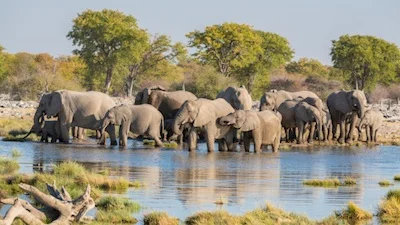Elephants are the biggest land animals.
There are elephants that live in Africa and there are elephants that live in Asia.
Elephants have big legs and round feet.
An elephant has a long nose called a trunk.
It helps elephants to pick up things, breathe, eat and drink
What's the difference between Asian and African elephants?
A group of African elephants ©Getty Images
African elephants are bigger than Asian elephants and have larger ears.
There are two groups of African elephants: savannah (grassland) elephants and forest elephants.
These two groups of African elephants have recently been recognised for the first time as two separate species, or kinds, of elephant.
The forest elephants are a bit smaller than the grasslands or savannah, elephants, with straighter and thinner tusks. Their ears are more rounded and their skulls have a different shape.
An Asian elephant enjoying a cool down in a river. ©Getty Images
Asian elephants have smaller ears because they live in tropical forests, and big ears would get torn in the branches. There are three groups of Asian elephants - Indian, Sumatran and Sri Lankan. The elephants of Borneo may be another sub species (small group within a group or kind).
One way elephants communicate is by making a loud trumpeting noise. Listen to that sound:
Elephant Bodies
Elephants are huge mammals. They are the largest of all the land animals. They have very big legs and round feet. They have short tails.
©Getty Images
All elephants have trunks, which have two points on the end that act like fingers. Trunks help an elephant pick up tiny objects and large logs. Trunks are used for smelling, breathing, touching, eating and drinking.
Adults use their trunks to stroke the young ones. The trunk is used like a hose to sprinkle dust over their bodies to cool them and protect them from insect bites, or to spray water into their mouths or over their bodies. To be able to do all this, an elephant's trunk has about 40,000 muscles in it!
A male African elephant. ©Getty Images
Ears are important. The large ears help the elephant keep cool because the veins are near the surface so blood cools in the ears on its way around the elephant's body.
Some elephants have tusks, which are big front teeth. The tusks help the elephant pick up food and help the animal protect itself. The bottom teeth are inside the elephant's mouth and are used to chew food.
Diet
Elephants eat large amounts of leaves, grass, fruit and bark. They spend about three quarters of the day feeding, eating up to 900 kilograms of food a day. They drink about 200 litres of water each day.
Life cycle
Elephants live in large groups called herds.
A female elephant is called a cow, the male is a bull and a baby elephant is called a calf.
An elephant cow gives birth to a calf about 22 months after mating with a bull elephant. Elephants are mammals, so a calf drinks milk from its mother. Elephants do this until they are about two years old.
A baby elephant. ©Getty Images
All the adults in the group help look after and teach the young elephants. When the herd is threatened, the calves are pushed to the centre of the group for protection. Cows help each other when one is giving birth, they babysit each other’s calves, and adopt calves whose mothers die. They have even been known to adopt an orphan calf from another herd. When an elephant dies, other elephants are sad. They go in small groups or alone to the body to say goodbye.
Elephants live for about 70 years.
Why are elephants important?
Because of their great size, elephants change their habitat as they move around. Their activities make new habitats for smaller creatures. For example, elephants break off tree branches as they feed, creating gaps and cracks in trees where small lizards can find shelter. As elephants march through forests they make gaps in the overhead canopy, so that sunlight reaches the forest floor, allowing plant species to grow, which in turn feeds small animals. Conserving elephants is therefore conserving whole ecosystems where the life cycle and survival of plants and animals are linked and depend on each other.
African elephant calf suckling milk from its mother. ©Getty Images
Conservation status and threats
Asian elephants are classified as endangered.
African forest elephants are classified as critically endangered and the savannah elephants as endangered.
Threats include habitat loss and conflict with humans. As their space gets smaller, elephants are in closer contact with humans. Elephants knock down fences and eat crops, so are pests to farmers.
Elephants are also killed for their ivory tusks, and even though that trade is banned, it continues illegally.
It’s a good idea to get information from more than one source!
Watch a video about ways that elephants communicate and care for each other:
https://thekidshouldseethis.com/post/elephants-incredible-intelligence
Read some fun facts about elephants:
https://www.natgeokids.com/au/discover/animals/general-animals/elephant-facts/








